Finding your path through bonsai wisdom is all about embracing the journey, not just the destination. I’ve learned that cultivating patience is key, as the beauty of bonsai takes time. Have you tried strategic pruning yet? It’s like shaping your life—it’s thoughtful, deliberate, and oh-so-satisfying. Balancing roots and foliage? It’s a dance! And let’s not forget Wabi-sabi, where imperfections tell the story. Ready for more revelations into this leafy adventure? Keep going, there’s much more to uncover!
Quick Takeaways
- Embrace patience by focusing on the slow growth of bonsai, prioritizing the journey over rapid results.
- Maintain a balance between roots and foliage to support overall health and energy distribution within the bonsai.
- Practice intentional pruning as an essential skill; limit cuts to one-third to guide growth effectively.
- Utilize wiring techniques to shape your bonsai, ensuring a 45° angle for optimal direction and growth.
- Acknowledge natural cycles and the beauty of imperfection, allowing your bonsai’s character and resilience to shine through.
The Essence of Patience in Bonsai Growth

The essence of patience in bonsai growth is nothing short of a zen-like journey, don’t you think?
Engaging in bonsai cultivation demands we embrace the snail’s pace of progress. Forget rapid rewards; it’s about those tiny, almost imperceptible transformations.
Each pruning, every careful water splash—it’s an exercise in mindfulness. You learn to savor the journey, not just the destination. Cultivating patience is an inherent part of this process, reinforcing the art’s emphasis on gradual transformation.
Let’s admit modern life craves instant gratification, but bonsai offers a totally different adventure.
Rooting yourself in the art of patience not only connects you with nature, but also cultivates power within.
Who knew slow and steady could feel this empowering?
Nurturing Balance: Root and Foliage Harmony
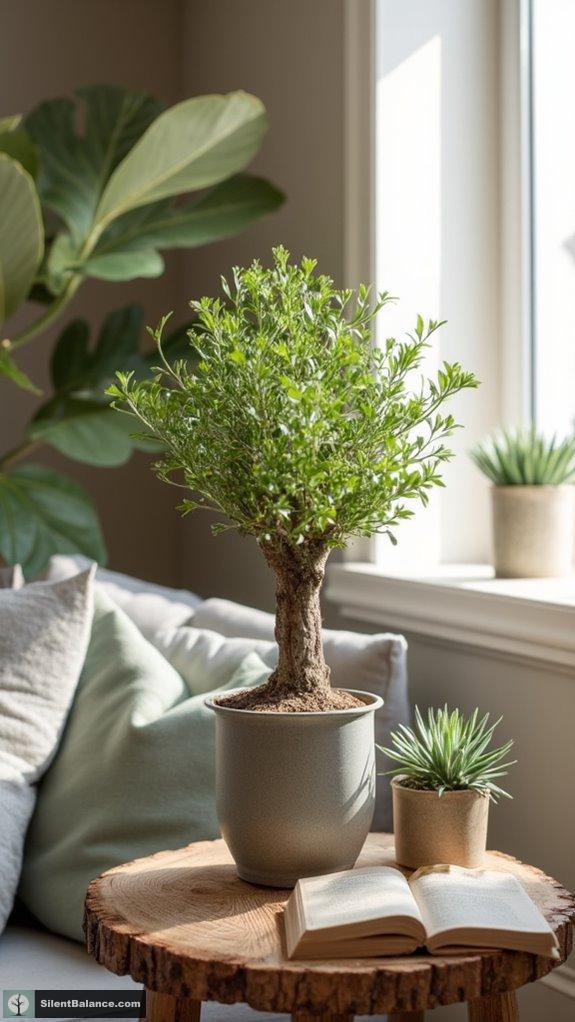
While nurturing a bonsai isn’t just about clipping branches and adjusting pots, finding harmony between roots and foliage is essential for keeping your little tree thriving.
Ever wonder how a delicate balance plays out? Excess foliage can drain energy faster than you can say “shohin.” It’s tempting to cut roots and branches in one fell swoop, but hold up—strategic pruning helps direct your tree’s energy effectively.
Finding the right balance in bonsai is crucial; overgrown foliage can sap energy, making strategic pruning essential for health.
Consider trimming about 30% of foliage after root pruning to promote healthier growth.
Keep in mind, bonsai isn’t a race; it’s a strategic battle for balance. So, are you ready to nurture your bonsai into a masterpiece?
The Art of Shaping: Pruning as a Life Skill

Finding the right balance in your bonsai journey doesn’t stop at roots and foliage; it beautifully extends into the art of shaping.
Pruning, my friends, isn’t just snipping away—it’s a bold statement of intent. Grab those sharp, sanitized shears, and keep in mind: no more than a third, folks! You’re not a lumberjack!
Each careful cut directs growth, shifting energy to where it truly matters.
Feeling adventurous? Pinch those softer foliage types for a clean break!
Embrace the rhythm of maintenance and structural pruning, and watch your tree transform, flourishing with vigor and grace.
Isn’t it empowering? Let’s channel our inner bonsai artists!
Wiring Your Path: Guiding Growth and Change
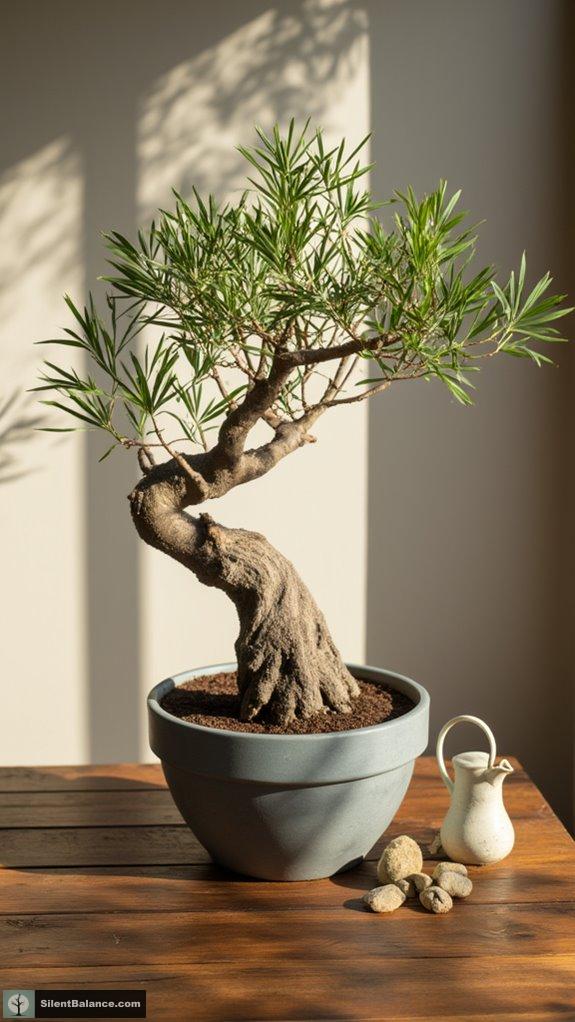
When you plunge into the world of bonsai, wiring becomes one of those essential skills that transforms the mundane into the magnificent. It’s not just about wrapping branches; it’s your secret weapon for shaping destiny.
Ever thought about the interplay of aluminum and copper? Aluminum’s flexibility meets copper’s endurance—like a dynamic duo in your bonsai studio!
Start with the trunk, then dance with primary branches. Recall—whenever you wire, aim for a 45° angle!
Begin by sculpting the trunk, then gracefully guide the primary branches, always maintaining that perfect 45° angle!
Don’t rush the process; timing and patience are key.
Embracing Natural Cycles: Mindfulness Through Care

In the world of bonsai, where every twist and turn of a branch tells a story, embracing the natural cycles of care feels like dancing to nature’s rhythm.
You see, each season has its own personality—from the dormancy of winter to the vigorous growth of spring. It’s about knowing when to water, prune, and fertilize, based on your bonsai’s whispers.
Have you ever felt the urge to meddle? Resist! Timing is everything; observe those budding leaves and adapt your care.
After all, a powerful bonsai flourishes not just with our hands, but by respecting its natural flow. Together, let’s cultivate this exquisite dance.
The Tranquility of Imperfection: Wabi-Sabi in Bonsai
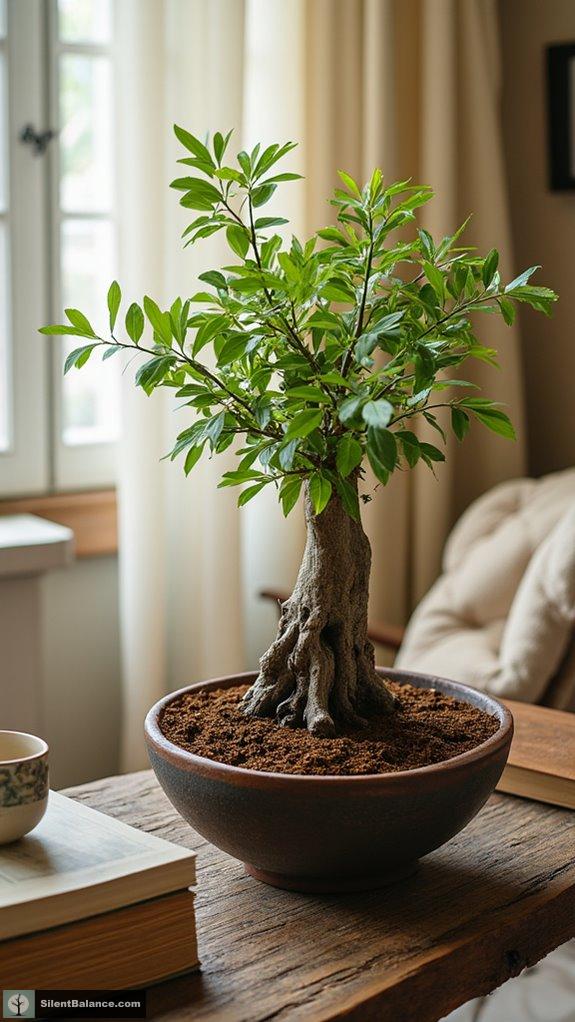
While it might be tempting to chase perfection in our bonsai journeys, embracing the beauty of wabi-sabi reveals a world rich with tranquility and depth.
Think about it: does a perfectly symmetrical tree ever spark the same awe as one shaped by time and nature?
Wabi-sabi encourages us to appreciate the rugged charm of age—the weathered bark and twisted trunks tell stories of resilience.
It’s about finding power in imperfection and realizing that each knot, each curve, enhances our connection to the natural world.
Finding Strength in Adaptation: Lessons From Nature
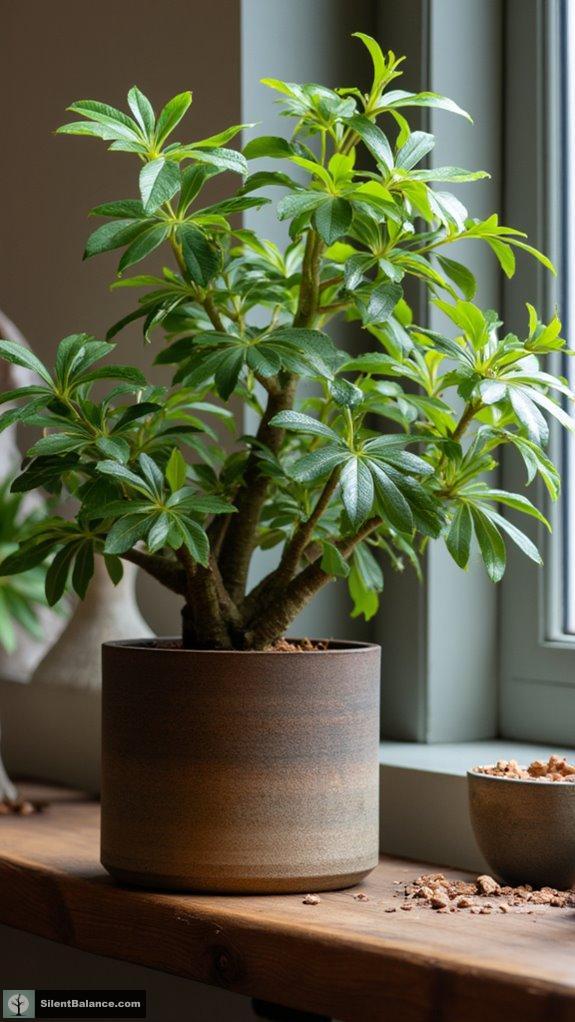
Adaptation is nature’s way of reminding us that flexibility can be just as important as strength.
Just like bonsai trees bending gracefully to the wind, we too can thrive through change.
Here are three key lessons I’ve learned:
- Genetic Variety: Populations evolve rapidly, harnessing their diversity to face new challenges.
- Local Success: Traits that enhance survival can lead to remarkable adaptability, even in adversity.
- Behavioral Buffers: Instead of relying solely on physical changes, I can leverage strategies, like a seasoned bonsai artist, to adapt in life’s wild environment.
Growth in Adversity
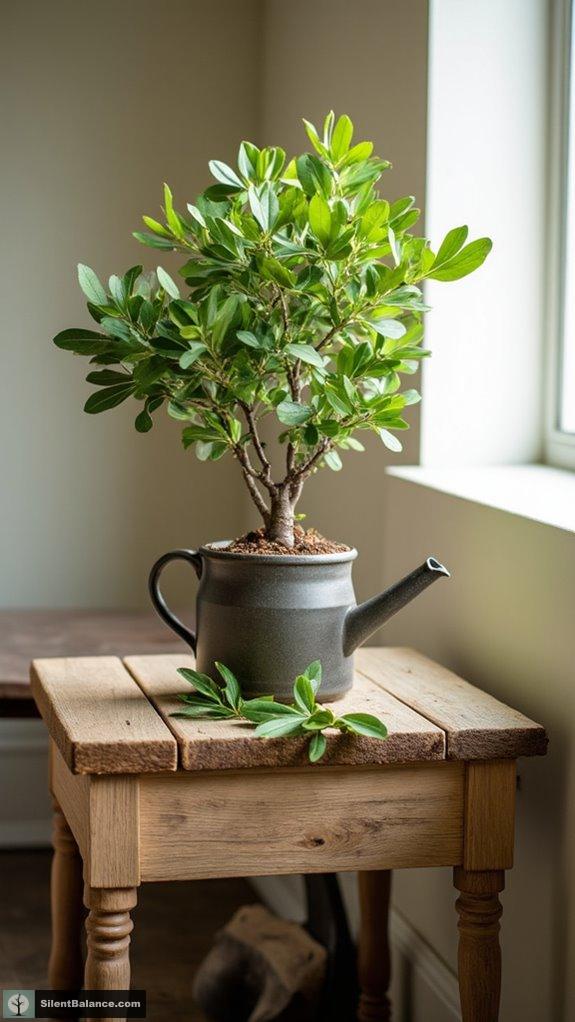
Growth in adversity isn’t just a concept; it’s a way of life for bonsai enthusiasts and their miniature trees.
Ever tried the humidity boost with a plastic bag? It’s genius! That close-to-100% humidity makes your bonsai feel like it’s on a tropical vacation, which helps keep it hydrated during stress.
And let’s talk air-layering—propagating roots on long trunks? That’s a game-changer for stability and aesthetics!
Pruning? Yes, please, but let’s not overdo it.
With balanced nutrients and strategic watering, you’re not just surviving tough times; you’re thriving. Different bonsai tree styles require specific nutrient ratios tailored to their individual needs, ensuring optimal growth even in challenging conditions.
Questions and Answers
What Bonsai Species Are Easiest for Beginners to Grow?
Think of Chinese Elm and Juniper in the outdoor domain—both embody resilience.
Isn’t it exhilarating to shape nature with your hands? Each small leaf and tender branch shapes not just the tree, but your journey as a bonsai artist.
How Often Should I Water My Bonsai Tree?
So, you’re wondering how often to water your bonsai? I get it—it’s essential for its health!
Generally, I water when the topsoil feels bone dry. Watch for temperature and wind, too; both can suck moisture like a sponge!
When summer kicks in, I might soak it daily. Just keep in mind, no strict schedules—it’s all about the feel.
Your bonsai will thank you for tuning in to its needs!
Happy bonsai-ing!
Can Bonsai Be Grown Indoors Successfully?
You can totally grow bonsai indoors and make them flourish like tiny green gods. Just think about giving them bright light and humidity—your Ficus will thank you for it!
You’ll want to keep a close eye on soil moisture, watching for that perfect balance—not a swimming pool or a desert.
And keep in mind, picking the right species, like the Dwarf jade, can elevate your bonsai game to legendary status! What’s not to love?
What Tools Do I Need for Basic Bonsai Care?
To kickstart your bonsai journey, you’ll need some essential tools. Pruning shears are your best friends for shaping those little green beauties.
Concave branch cutters help you avoid unsightly scars when trimming branches, while wire cutters prevent bark damage during training.
Don’t forget about bonsai scissors for elaborate detailing!
Got your tools ready? Let’s dig deep into the art of bonsai—where patience meets precision and a little whimsy never hurts!
How Long Does It Take for a Bonsai to Mature?
Ah, the age-old question of bonsai maturation! You might think it’s a race, but it’s more of a slow dance.
Typically, you’re looking at 5 years just to reach a miniature size, and then an extra 10 to 15 years for styling mastery.
That’s right—patience is your best friend here. Think of it as a lifelong commitment.
Have you got the stamina to nurture a bonsai for decades? You’ll be rewarded for it, trust me!
References
- https://en.wikipedia.org/wiki/Bonsai_cultivation_and_care
- https://www.bonsaiempire.com/basics/
- https://www.pubs.ext.vt.edu/426/426-601/426-601.html
- https://www.instructables.com/Starting-a-Bonsai/
- https://www.bonsaiempire.com
- https://www.idyl.co.in/blogs/blog/the-transformative-power-of-bonsai-lessons-in-patience-and-growth
- https://learn.nebonsai.com/bonsai-skills/bonsai-tree-care-expert-tips/
- https://greengoddess.com/the-zen-of-bonsai-cultivating-tranquility-in-miniature-landscapes/
- https://www.bonsaiempire.com/basics/cultivation/from-seeds
- https://blueskybonsai.com/2023/04/20/balancing-branches-and-roots/
- Imperial Bonsai: 6 Sacred Trees of Antiquity - August 25, 2025
- 7 Spiritual Lessons Bonsai Trees Teach Us - August 25, 2025
- What Does Bonsai Teach Us About Buddhist Growth? - August 24, 2025

